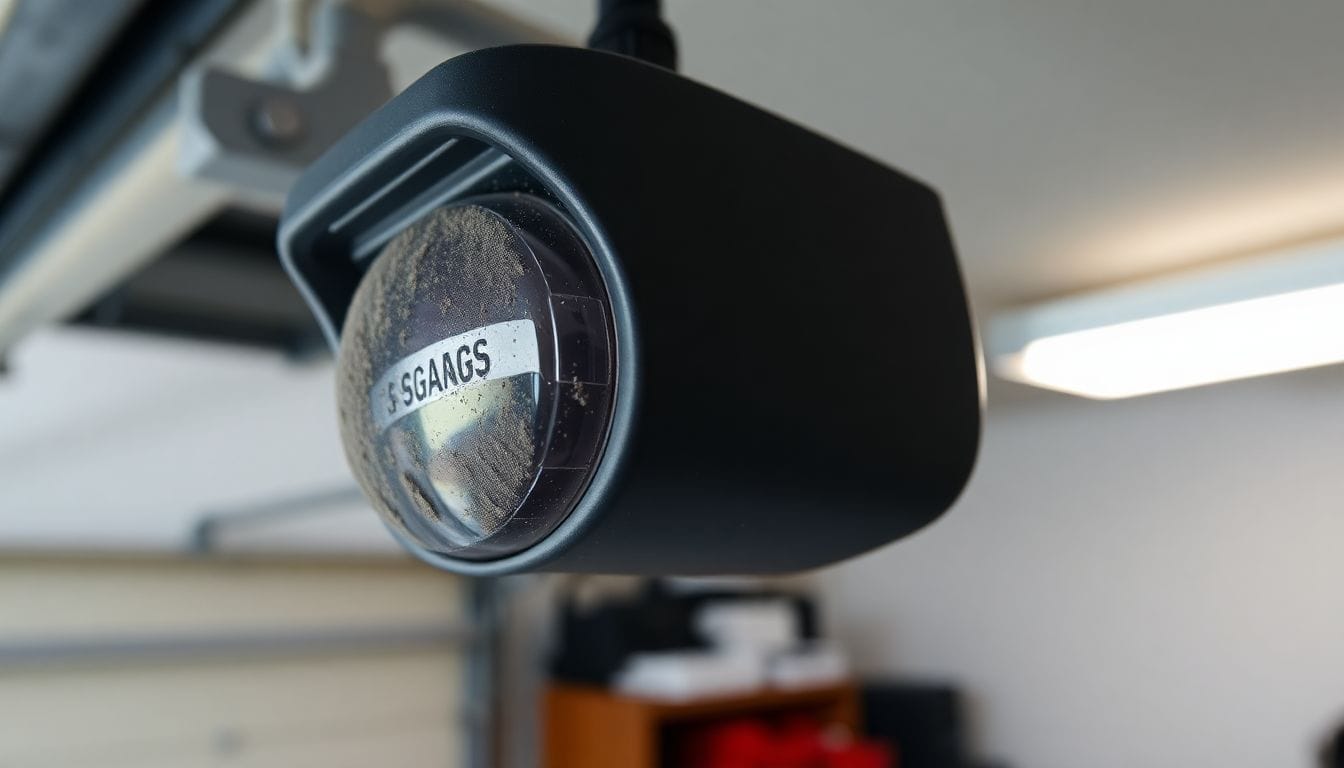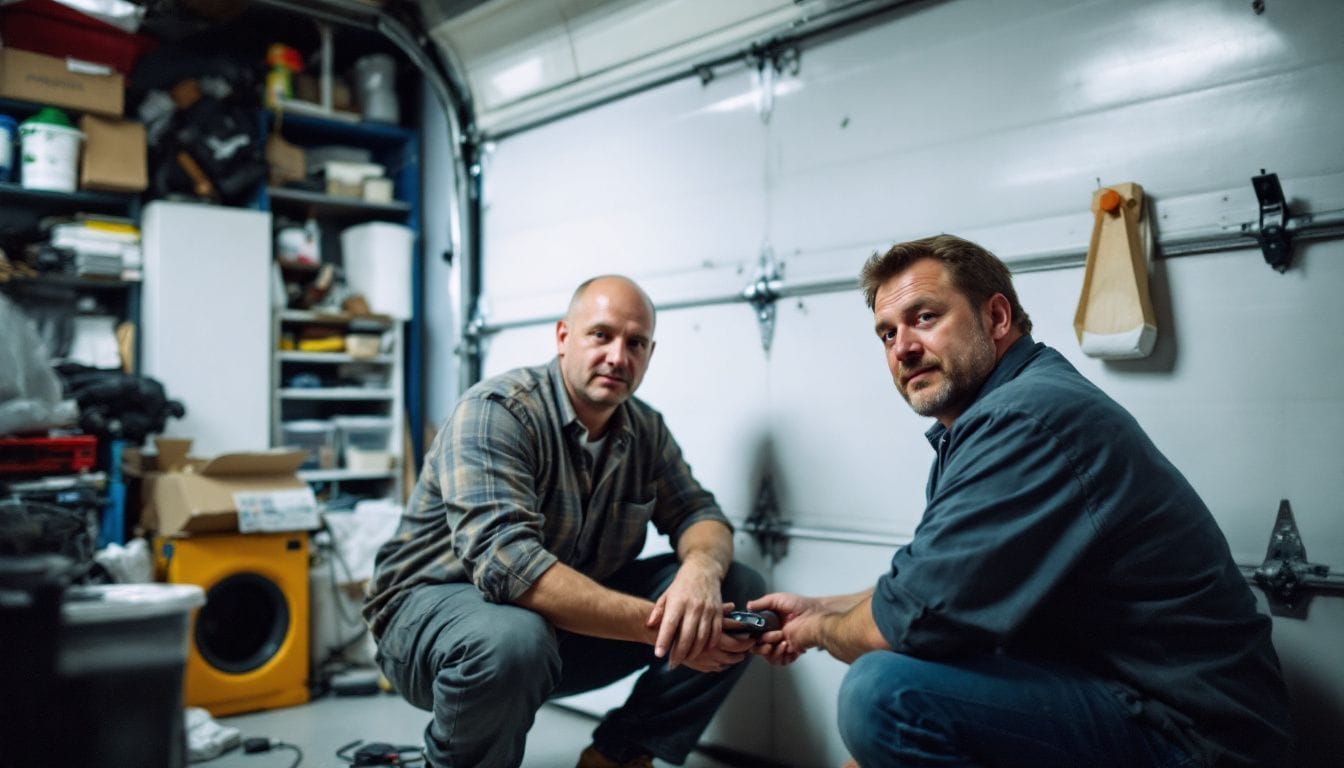Garage Door Sensor Repair
Are you struggling with a garage door that won’t close? Faulty garage door sensors are a common issue that can compromise your home’s safety. Garage door sensor repair is essential to ensure your door operates smoothly and protects against accidents.
Keep reading to learn how to fix your sensors quickly and easily.
Key Takeaways
- Maintain Sensor Cleanliness and Alignment: Regularly clean the sensor lenses and ensure they are properly aligned to prevent garage doors from malfunctioning and to maintain home safety.
- Identify and Address Common Issues: Watch for signs like door reversing or sensor lights flashing. Common problems include dirt buildup, misaligned sensors, and damaged wiring.
- Follow Simple Repair Steps: Check the power supply, clean and realign sensors, test their functionality, and replace them if necessary to keep your garage door operating smoothly.
- Seek Professional Help When Needed: If DIY repairs don’t fix the issue, contact experts like Sam’s Garage Doors Repair to handle complex problems safely and effectively.
- Understand the Importance of Safety Sensors: Since 1993, functional safety sensors have been essential for preventing accidents by detecting obstacles and ensuring the garage door operates safely.
Identifying Issues with Garage Door Sensors

After understanding the basics of your garage door system, it’s crucial to identify any issues with the garage door sensors. Malfunctioning garage door sensors can prevent the door from closing properly, posing safety risks.
Look for signs like the door reversing unexpectedly or failing to close altogether. Sensors out of alignment often cause these problems, making it essential to realign them correctly.
Flashing or non-lit safety sensor lights indicate a malfunction, signalling that the sensors are not working correctly. Dust and dirt on the sensor lenses can also disrupt the infrared beam, leading to sensor issues quickly and easily.
Ensuring your garage door sensors function properly is key to maintaining a safe home environment.
Regularly checking the wiring and power supply can help troubleshoot sensor problems. If the garage door won’t close or the sensors’ lights are off, inspect the wire connections for any damage.
Addressing these issues quickly and easily can prevent further complications and costly repairs.
Common Causes of Sensor Malfunction
Various factors can cause your garage door safety sensors to malfunction. Physical damage, such as broken springs or damaged cables, disrupts sensor functionality and the door’s operation.
Misaligned sensors prevent the light beam from connecting properly, making the door reverse or stop unexpectedly. Dirt accumulation on the sensor lenses blocks the light beam, hindering accurate detection of obstructions.
Furthermore, issues with the garage door opener, including malfunctions or power outages, interfere with sensor performance. Regular maintenance helps identify and address these common problems, ensuring your garage door operates safely and efficiently.
Wear and tear over time weakens essential components, leading to sensor issues. Broken garage door parts pose safety risks and disrupt the sensor’s ability to function correctly.
Power outages can stop the garage door from closing, as sensors rely on a consistent power supply to operate. Cleaning the sensors regularly removes dust and debris, restoring their light beams and ensuring proper alignment.
Addressing these common causes promptly can prevent costly repairs and maintain the safety features of your garage door system.
Steps to Repair Garage Door Sensors
Repairing garage door sensors ensures your garage door operates safely. Follow these steps to fix your garage door sensors quickly and effectively.
- Check the Power Supply
- Ensure the garage door opener is plugged into a working outlet.
- Test the outlet by plugging in another device, like a lamp.
- Verify that the garage door opener’s motor is receiving power.
- Clean the Sensors
- Turn off the power to the garage door opener.
- Use a clean cloth to wipe the sensor lenses on both sides of the garage door.
- Remove any dust, dirt, or debris that may block the sensors.
- Align the Sensors
- Inspect both sensors to ensure they are pointing directly at each other.
- Adjust the sensors by gently moving them until the indicator lights are steady.
- Make sure the sensors are at the same height and properly aligned with each other.
- Test the Sensors
- Restore power to the garage door opener.
- Close the garage door and place an object in its path.
- Observe if the door reverses when it contacts the object. If it does, the sensors are working correctly.
- Replace the Sensors
- Disconnect the power to the garage door opener.
- Unscrew the old sensors from their mounting positions on the wall or door.
- Cut the wires and connect the new sensors using blue wire nuts.
- Secure the new sensors in place and reconnect the power to the garage door opener.
- Final Testing
- Open and close the garage door to ensure the new sensors function properly.
- Check that the door stops and reverses when an object is detected.
- Ensure the safety and functionality of your garage door sensors.
Following these steps can help you troubleshoot and fix your garage door sensors yourself. If problems persist, contact a garage door technician for professional garage door service.
Preventative Maintenance Tips
Regular maintenance keeps your garage door sensors working properly and ensures safety. Follow these tips to avoid issues with your garage door and prolong sensor life.
- Clean the Sensor Lenses Regularly Dust and dirt can block the photoelectric effect, causing sensors to malfunction. Clean the sensor lenses every few months or when they appear dirty. Use a soft cloth to wipe both sides of the garage door sensor lenses, ensuring clear visibility for the transmitter and receiver.
- Check Sensor Alignment Misaligned sensors can prevent the garage door from opening or closing correctly. Inspect the alignment of sensors on either side of the garage door regularly. If you notice the sensors are out of place, adjust them back in position to maintain the functioning of your garage door.
- Inspect Wiring for Damage Damaged wires can disrupt the communication between sensors and the garage door opener motor. Examine the white wires and other connections for signs of wear or breaks. Replace any faulty wires to ensure your garage door operates safely and effectively.
- Install Protective Brackets Frequent misalignment can occur due to vibrations or external factors. Install protective brackets to keep sensors securely in place. These brackets help maintain the correct positioning, reducing the need for frequent adjustments and sensor replacements.
- Schedule Periodic Maintenance Regular maintenance helps identify potential issues before they become major problems. Schedule an appointment with a professional for comprehensive garage door repair and sensor troubleshooting. This proactive approach ensures your garage door remains compatible with safety standards and operates smoothly.
When to Seek Professional Help
Persistent issues with a broken garage door sensor often require professional attention. If you’ve tried all the troubleshooting steps, such as cleaning the sensor lenses or realigning the sensors, and the door still doesn’t operate correctly, it’s time to seek expert help.
Damaged wires or persistent alignment problems can pose significant safety risks and should be handled by professionals to prevent injury or further damage.
Sam’s Garage Doors Repair specialises in replacing garage door sensors and managing complex repairs efficiently. Wiring replacements and sensor replacements are best left to experienced technicians to ensure compatibility and functionality.
Supplementary insights on Garage Door Sensors
Explore the essential roles and common questions about garage door sensors to boost your door’s safety and efficiency – read on to learn more.
Importance of Functional Safety Sensors
Functional safety sensors play a vital role in safeguarding your home by ensuring garage doors operate smoothly and safely. Since 1993, automatic garage door kits have included photoelectric safety sensors to prevent accidents.
These sensors detect obstacles, stopping the door from closing on something or someone. If the green lights on the sensors are off or flickering, it may indicate a problem with the alignment or that the wires are damaged.
Dust or dirt can also block the sensors, causing the door to malfunction. Knowing the type of garage door sensor you have helps when you need to replace garage door sensors yourself or decide to call a professional for help.
Maintaining functional safety sensors reduces the risk of door-related injuries and property damage. Common reasons sensors stop working include misalignment, damaged wires, and debris blocking the sensor’s view.
Regular cleaning can prevent dust or dirt from interfering with sensor operations. When the door doesn’t respond correctly, it’s important to check the sensors first before investing in a new garage door opener.
DIY home repairs can save money, but some issues, like serious wiring problems, require hiring a professional. Ensuring your sensors are in good condition keeps your garage door opener compatible with your system and your home safe.
Frequently Asked Questions about Garage Door Sensors
Garage door sensors play a crucial role in ensuring the safety of your home. Understanding how they work and how to maintain them can prevent accidents and costly repairs.
- How often should I clean my garage door sensors?Clean your sensors every few months or whenever they appear dirty. Dirt and debris can block the sensor’s view, causing the door to malfunction.
- What are the signs that my garage door sensors are malfunctioning?If your garage door opens and closes without responding to obstacles, or if one or both indicator lights on the sensors are off, there might be an issue.
- Can I repair garage door sensors myself?Yes, many sensor issues can be fixed do it yourself. Ensure the sensors are aligned and the wires are intact. Replace any damaged wires or parts as needed.
- Why do my garage door sensors keep getting misaligned?Frequent misalignment can occur due to vibrations from the garage door opener. Install protective brackets to keep the sensors in place.
- What should I do if replacing the garage door sensors doesn’t solve the problem?If repairs don’t work, contact a professional. There may be underlying issues with the garage door opener or wiring that need expert attention.
- Are there safer options for garage door sensors?Modern sensors are designed for enhanced safety. Replacing old or ineffective sensors with new ones offers a safer option for your home.
- How do I choose a compatible garage door sensor for my opener?Ensure the new sensor matches your garage door opener’s specifications. Check compatibility before purchasing to avoid installation issues.
- Do garage door sensors affect the operation of the garage door opener?Yes, sensors communicate with the opener to stop the door if an obstacle is detected. Functional sensors prevent the door from closing on objects or people.
- What materials are garage door sensors made from?Sensors typically have a plastic or metal housing with electronic components. Durable materials help them withstand outdoor conditions.
- Can I receive a commission by recommending garage door sensors?Some companies offer affiliate programs. If you replace your garage door sensors through a partner link, you might receive a small commission.
Choosing the Right New Garage Door with Functional Safety Sensors
Select a garage door that is compatible with your garage door opener and includes functional safety sensors. Since 1993, photoelectric sensors have been mandatory in automatic garage door kits across the United States.
Ensure the sensors get properly installed and connect to the white terminal for optimal performance. Deluxe Door Systems Inc in Ohio has received praise for their reliable sensor setups, demonstrating the importance of professional installation.
Properly installed sensors activate one or both lights, enhancing the safety of your home by preventing accidents and ensuring smooth operation.
Conclusion
Properly working garage door sensors are vital for keeping your home safe. Regular maintenance can prevent accidents and ensure smooth operation. If you notice sensor problems, try the repair steps or call a professional for help.
Taking care of your sensors ensures your garage door stays reliable and secure. Stay proactive to maintain a safe environment for your family.
FAQs
1. How can YouTube assist with garage door sensor repair?
YouTube offers many videos on repairing garage door sensors. Click on one that matches your garage door opener model. Use the transcript to follow steps like replacing the wires and ensuring sensors are back in place.
2. What should I do if my garage door opener stops working?
Remember that sensors might be misaligned or have damaged wires. Switch off the garage door opener and check the sensors. If needed, replace the wires. You can find tutorials on YouTube or give us a call for professional help.
3. When is it necessary to replace the wires in garage door sensors?
If the wires are frayed or not connecting properly, it’s time to replace them. Damaged wires can prevent sensors from working correctly. Watch YouTube videos for guidance and use the transcript to ensure sensors are back in place.
4. Why should I contact a professional for garage door sensor issues?
If YouTube tutorials are unclear or the problem persists, give us a call. Professionals can accurately replace wires and ensure all sensors are properly aligned, making sure your garage door opener stops safely.
Fast, Affordable Garage Door Repair
For affordable garage door repair, call Reece at (07) 5515 0277. Visit us today for expert assistance and quick service you can trust!

